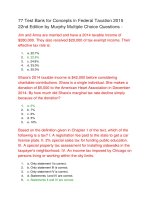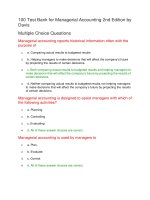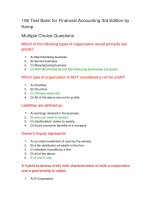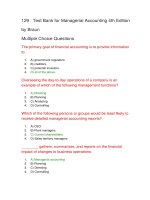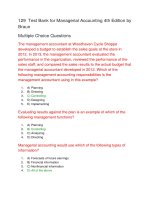78 test bank for managerial accounting 4th edition by wild đề trắc nghiệm có đáp án
Bạn đang xem bản rút gọn của tài liệu. Xem và tải ngay bản đầy đủ của tài liệu tại đây (113.95 KB, 25 trang )
78 Test Bank for Managerial Accounting 4th Edition
by Wild
Multiple Choice Questions
The following costs are included in a recent summary of data for a
company: advertising expense, $85,000; depreciation expense –
factory building, $133,000; direct labor, $250,000; direct material
used, $300,000; factory utilities, $105,000; and sales salaries
expense, $150,000. Determine the dollar amount of conversion
costs.
1.
A. $1,023,000
2.
B. $550,000
3.
C. $488,000
4.
D. $235,000
5.
E. $238,000
Flexibility of practice when applied to managerial accounting
means that:
1.
A. The information must be presented in electronic format so that it is easily
changed.
2.
B. Managers must be willing to accept the information as the accountants
present it to them, rather than in the format they ask for.
3.
C. The managerial accountants need to be on call 24 hours a day.
4.
D. The design of a company's managerial accounting system largely
depends on the nature of the business and the arrangement of the internal
operations of the company.
5.
E. Managers must be flexible with information provided in varying forms
and using inconsistent measures.
Days’ sales in raw materials inventory is a measure of:
1.
A. How much raw materials are needed for the company to earn a profit.
2.
B. How long it takes the company to pay for raw materials..
3.
C. How many times a company turns over its raw materials during a period.
4.
D. How long it takes raw materials to be used in production.
5.
E. The product costs a company has incurred during a period.
The following costs are included in a recent summary of data for a
company: advertising expense, $85,000; depreciation expense –
factory building, $133,000; direct labor, $250,000; direct material
used, $300,000; factory utilities, $105,000; and sales salaries
expense, $150,000. Determine the dollar amount of prime costs.
1.
A. $1,023,000 - Given
2.
B. $550,000
3.
C. $488,000
4.
D. $235,000
5.
E. $238,000
Raw materials that physically become part of the product and can
be traced to specific units or batches of product are called:
1.
A. Raw materials sold
2.
B. Chargeable materials
3.
C. Goods in process
4.
D. Indirect materials
5.
E. Direct materials
The way of doing business whose goal is to eliminate waste while
satisfying the customer and providing a positive return to the
company is:
1.
A. Total quality management.
2.
B. Managerial accounting.
3.
C. Customer orientation.
4.
D. Continuous improvement.
5.
E. Lean business model. - Given
A company reports raw materials used of $42,750 for a year, with
beginning raw materials inventory of $4,000 and an ending raw
materials inventory of $4,500. Compute days’ sales in raw
materials inventory based on this data.
1.
A. 10.52 days.
2.
B. 34.15 days
3.
C. 10.06 days
4.
D. 38.42 days
5.
E. 9.35 days
Continuous improvement:
1.
A. Is a measure of profits.
2.
B. Is a measure of costs.
3.
C. Rejects the notion of "good enough."
4.
D. Is not applicable to most businesses.
5.
E. Is possible only in service businesses.
Product costs:
1.
2.
A. Are expenditures necessary and integral to finished products.
B. Are expenditures identified more with a time period rather than with
finished products.
3.
C. Include selling and administrative expenses.
4.
D. Are only costs that vary with the volume of activity.
5.
E. Are only costs that do not vary with the volume of activity. - Given
Costs that flow directly to the current income statement are
called:
1.
A. Period costs.
2.
B. Product costs.
3.
C. General costs.
4.
D. Balance sheet costs.
5.
E. Capitalized costs.
Which of the following costs is not included in factory overhead?
1.
A. Payroll taxes on the wages of supervisory factory workers.
2.
B. Indirect labor.
3.
C. Depreciation of manufacturing equipment.
4.
D. Manufacturing supplies used.
5.
E. Direct materials.
Labor costs that are clearly associated with specific units or
batches of product because the labor is used to convert raw
materials into finished products called are:
1.
A. Sunk labor
2.
B. Direct labor
3.
C. Indirect labor
4.
D. Finished labor
5.
E. Supervisory labor
Managerial accounting information:
1.
2.
A. Is used mainly by external users.
B. Involves gathering information about costs for planning and control
decisions.
3.
C. Is generally the only accounting information available to managers.
4.
D. Can be used for control purposes but not for planning purposes.
5.
E. Has little to do with controlling costs.
Costs that are first assigned to inventory are called:
1.
A. Period costs
2.
B. Product costs
3.
C. General costs
4.
D. Administrative costs
5.
E. Fixed costs
A management concept that applies quality improvement to all
aspects of business activities is called:
1.
A. Continuous operations.
2.
B. Customer orientation.
3.
C. Just-in-time.
4.
D. Managerial accounting.
5.
E. Total quality management.
The Malcolm Baldrige Award was established by:
1.
A. The United Nations.
2.
B. The U. S. Chamber of Commerce.
3.
C. The Malcolm Baldrige Foundation.
4.
D. The U. S. Congress.
5.
E. The SEC.
Classifying costs by behavior involves:
1.
A. Identifying fixed cost and variable cost.
2.
B. Identifying cost of goods sold and operating costs.
3.
C. Identifying all costs.
4.
D. Identifying costs in a physical manner.
5.
E. Identifying both quantitative and qualitative cost factors.
Assuming production needs can be met, companies usually
prefer:
1.
A. A lower number of days’ sales in raw materials inventory.
2.
B. A higher number of days’ sales in raw materials inventory.
3.
4.
5.
C. That days’ sales in inventory be higher than the days in the accounting
period.
D. That days’ sales in inventory be greater than the operating cycle
E. That days’ sales in inventory be equal to the days in the accounting
period
The following are all examples of product costs:
1.
A. Direct material, direct labor and indirect labor.
2.
B. Direct labor, VP of sales salary, and insurance on the factory.
3.
4.
5.
C. Depreciation on the factory equipment, depreciation on the office
building, and depreciation on the factory building.
D. Factory insurance, interest expense, and property taxes on the factory.
E. Office supplies, sales commissions, and maintenance costs on office
copier.
Materials that are used in support of the production process but
that do not become a part of the product and are not clearly
identified with units or batches of product are called:
1.
A. Secondary materials
2.
B. General materials
3.
C. Direct materials
4.
D. Indirect materials
5.
E. Materials inventory
Which of the following is never included in direct materials costs?
1.
A) Invoice costs of direct materials.
2.
B) Outgoing delivery charges.
3.
C) Materials storage costs.
4.
D) Materials handling costs.
5.
E) Insurance on stored material.
Which of the following statements is true?
1.
A. The IMA’s Statement of Ethical Professional Practice requires
management accountants to be incompetent, maintain confidentiality, act
with integrity, and communicate information in a fair and credible manner.
2.
B. The IMA’s Statement of Ethical Professional Practice requires
management accountants to be competent, maintain confidentiality,
eliminate all fraud, and communicate information in a fair and credible
manner.
3.
C. The IMA’s Statement of Ethical Professional Practice requires
management accountants to be incompetent, maintain confidentiality, act
with integrity, and miscommunicate information in a credible manner.
4.
D. The IMA’s Statement of Ethical Professional Practice requires
management accountants to be competent, maintain confidentiality, act with
integrity, and communicate information in a fair and credible manner.
5.
E. The IMA’s Statement of Ethical Professional Practice requires
management accountants to perform certain checks for fraud, act with
integrity, and communicate information in a fair and credible manner.
Costs classified by controllability are useful for:
1.
A. The balance sheet
2.
B. The income statement
3.
C. The budgeting process
4.
D. Evaluation reports
5.
E. Determining product cost
Managerial accounting is different from financial accounting in
that:
1.
A. Managerial accounting is more focused on the organization as a whole
and financial accounting is more focused on subdivisions of the organization.
2.
B. Managerial accounting never includes nonmonetary information.
3.
C. Managerial accounting includes many projections and estimates
whereas financial accounting has a minimum of predictions.
4.
D. Managerial accounting is used extensively by investors, whereas
financial accounting is used only by creditors.
5.
E. Managerial accounting is mainly used to set stock prices.
The salary paid to the supervisor of an assembly line would
normally be classified as:
1.
A. Direct labor
2.
B. Indirect labor
3.
C. A period cost
4.
D. A general cost
5.
E. An assembly cost
Another title for goods in process inventory is:
1.
A. Indirect materials inventory.
2.
B. Work in process inventory.
3.
C. Conversion costs.
4.
D. Direct materials inventory.
5.
E. Raw materials inventory.
Goods a company acquires to use in making products are called:
1.
A. Cost of goods sold.
2.
B. Raw materials inventory.
3.
C. Finished goods inventory.
4.
D. Goods in process inventory.
5.
E. Conversion costs.
Which of the following is not a characteristic of all fraud?
1.
A. It is done to provide direct or indirect benefit to the employee.
2.
B. It violates the employee’s duties to his employer.
3.
C. It costs the employer money.
4.
D. It is secret.
5.
E. Can be intentional or unintentional.
An opportunity cost is:
1.
A. An uncontrollable cost.
2.
B. A cost of potential benefit lost.
3.
C. A change in the cost of a component.
4.
D. A direct cost.
5.
E. A sunk cost.
A direct cost is a cost that is:
1.
A. Identifiable as controllable.
2.
B. Recorded as part of manufacturing overhead.
3.
C. Fixed with respect to the volume of activity.
4.
D. Traceable to a cost object.
5.
E. Sunk with respect to a cost object.
A management concept that encourages all managers and
employees to be in tune with the wants and needs of customers,
and which leads to flexible product designs and production
processes, is called:
1.
A. Continuous improvement.
2.
B. Customer orientation.
3.
C. Just-in-time.
4.
D. Theory of constraints.
5.
E. Total quality management.
An approach to managing inventories and production operations
such that units of materials and products are obtained and
provided only as they are needed is called:
1.
A. Continuous improvement.
2.
B. Customer orientation.
3.
C. Just-in-time manufacturing.
4.
D. Theory of constraints.
5.
E. Total quality management.
Costs that are incurred as part of the manufacturing process but
are not clearly associated with specific units of product or batches
of production, including all manufacturing costs other than direct
material and direct labor costs, are called:
1.
A. Administrative expenses
2.
B. Nonmanufacturing costs
3.
C. Sunk costs
4.
D. Factory overhead
5.
E. Preproduction costs
Which of the following statements regarding fraud is true?
1.
A. Fraud is a deliberate act.
2.
B. Fraud can be deliberate or unintentional.
3.
C. A company with a strong code of ethics can eliminate fraud.
4.
D. A company with strong internal controls can eliminate fraud.
5.
E. The most common type of fraud is financial statement fraud.
Products that are in the process of being manufactured but are
not yet complete are called:
1.
A. Raw materials inventory.
2.
B. Conversion costs.
3.
C. Cost of goods sold.
4.
D. Goods in process inventory.
5.
E. Finished goods inventory.
Which of the following costs would not be classified as factory
overhead?
1.
A. Property taxes on maintenance machinery.
2.
B. Expired insurance on factory equipment.
3.
C. Wages of the factory janitor.
4.
D. Metal doorknobs used on wood cabinets produced.
5.
E. Small tools used in production.
The cost of labor that is not clearly associated with specific units
or batches of product is called:
1.
A. Unspecified labor
2.
B. Direct labor
3.
C. Indirect labor
4.
D. Basic labor
5.
E. Joint labor
Products that have been completed and are ready to be sold by
the manufacturer are called:
1.
A. Finished goods inventory.
2.
B. Goods in process inventory.
3.
C. Raw materials inventory.
4.
D. Cost of goods sold.
5.
E. Factory supplies.
A fixed cost:
1.
A. Requires the future outlay of cash and is relevant for future decision
making.
2.
B. Does not change with changes in the volume of activity within the
relevant range.
3.
C. Is directly traceable to a cost object.
4.
D. Changes with changes in the volume of activity within the relevant
range.
5.
E. Has already been incurred and cannot be avoided so it is irrelevant for
decision making.
The Institute of Management Accountants has developed a code
of ethics that requires management accountants to behave in
certain ways. Which of the following behaviors is not required?
1.
A. Competence.
2.
B. Integrity.
3.
C. Maintenance of confidentiality.
4.
D. Communication of information in credible manner.
5.
E. Timeliness.
An attitude of constantly seeking ways to improve company
operations, including customer service, product quality, product
features, the production process, and employee interactions, is
called:
1.
A. Continuous improvement.
2.
B. Customer orientation.
3.
C. Just-in-time.
4.
D. Theory of constraints.
5.
E. Total quality measurement.
Period costs for a manufacturing company would flow directly to:
1.
A, The current income statement.
2.
B, Factory overhead.
3.
C, The current balance sheet.
4.
D, Job cost sheet.
5.
E, The current manufacturing statement.
The three major cost components of a manufactured product are:
1.
A. Marketing, selling, and administrative costs.
2.
B. Indirect labor, indirect materials, and miscellaneous factory expenses.
3.
C. Direct materials, direct labor, and factory overhead.
4.
D. Differential costs, opportunity costs, and sunk costs.
5.
E. General, selling, and administrative costs.
78 Free Test Bank for Managerial Accounting 4th
Edition by Wild Multiple Choice Questions - Page 2
Hardy Co.'s cost of goods manufactured for the current year is:
1.
A) $12,000
2.
B) $16,100
3.
C) $17,100
4.
D) $18,100
5.
E) $13,600
What is the correct amount of overhead?
1.
A. $192,000.
2.
B. $110,500.
3.
C. $200,000.
4.
D. $150,000.
5.
E. $ 77,500.
Juliet Corporation has accumulated the following accounting data
for the year: Finished goods inventory, January 1 $3,200;
Finished goods inventory, December 31 4,000; Total cost of
goods sold 4,200. The cost of goods manufactured for the year
is:
1.
A. $200
2.
B. $1,000
3.
C. $5,000
4.
D. $6,400
5.
E. $8,200
A manufacturing statement is also known as a schedule or listing
of the:
1.
A. Raw materials processed.
2.
B. Factory supplies used.
3.
C. Cost of goods manufactured.
4.
D. Total finished goods.
5.
E. Cost of goods sold.
Which of the following items appears only in a manufacturing
company's financial statements?
1.
A. Cost of goods sold.
2.
B. Cost of goods manufactured.
3.
C. Goods available for sale.
4.
D. Gross profit.
5.
E. Net income.
The beginning and ending finished goods inventories of a
company were $91,000 and $94,000 respectively. If cost of goods
sold equaled $800,000, what is the amount of cost of goods
manufactured for this period?
1.
A. $706,000
2.
B. $709,000
3.
C. $797,000
4.
D. $803,000
5.
E. $3,000
Use the following information to compute the total manufacturing
costs incurred during the period: Beginning raw materials $ 5,500;
Ending raw materials 4,000; Direct labor 12,250; Raw material
purchases 7,400; Depreciation on factory equipment 6,500;
Factory repairs and maintenance 3,300; Beginning finished goods
inventory 10,200; Ending finished goods inventory 8,900;
Beginning goods in process inventory 5,700; Ending goods in
process inventory 6,300
1.
A. $36,650
2.
B. $30,950
3.
C. $30,650
4.
D. $30,350
5.
E. $31,650
What is the correct amount of cost of goods manufactured?
1.
A. $398,500.
2.
B. $386,000.
3.
C. $309,000.
4.
D. $306,000.
5.
E. $296,500.
Total manufacturing costs incurred during the year do not
include:
1.
A. Direct materials used.
2.
B. Factory supplies used.
3.
C. Goods in process inventory, beginning balance.
4.
D. Direct labor.
5.
E. Depreciation of factory machinery.
Compute cost of goods manufactured for this period given the
following amounts. Ending finished goods inventory $66,000;
Cost of goods sold 54,000; Beginning finished goods inventory
60,000
1.
A. $72,000
2.
B. $48,000
3.
C. $60,000
4.
D. $66,000
5.
E. $180,000.
Factory overhead costs normally include all of the following
except:
1.
A. Indirect labor costs
2.
B. Indirect material costs
3.
C. Selling costs
4.
D. Factory machinery oil
5.
E. Factory rent
The following information relates to the manufacturing operations
of the IMH Publishing Corporation for the year: Raw materials
inventory: $ 57,000 (Beginning); $60,000 (Ending). Finished
goods: 68,000 (Beginning); 60,000 (Ending). The raw materials
used in manufacturing during the year totaled $118,000. Raw
materials purchased during the year amount to:
1.
A. $107,000
2.
B. $115,000
3.
C. $118,000
4.
D. $121,000
5.
E. $126,000
Which of the following accounts would appear on a manufacturing
statement?
1.
A. Raw materials, factory insurance expired, indirect labor.
2.
B. Raw materials, goods in process, finished goods.
3.
C. Factory buildings, delivery equipment, and depreciation on factory
equipment.
4.
D. Direct labor, indirect labor, sales salaries.
5.
E. Direct labor, factory repairs and maintenance, wages payable.
Use the following information to compute the cost of goods
manufactured: Beginning finished goods inventory $65,000;
Beginning goods in process inventory 81,000; Beginning raw
materials 73,000; Depreciation on factory equipment 7,000; Direct
labor 25,000; Ending finished goods inventory 67,000; Ending
goods in process inventory 79,000; Ending raw materials 60,000;
Factory repairs and maintenance 12,000; Raw material
purchases 50,000
1.
A. $63,000
2.
B. $105,000
3.
C. $107,000
4.
D. $90,000
5.
E. $109,000
The total of Hardy Co.'s manufacturing costs added during the
current year is:
1.
A. $12,000
2.
B. $16,100
3.
C. $17,100
4.
D. $18,100
5.
E. $13,600
Use the following information to compute the cost of goods
manufactured: Beginning raw materials $ 5,500; Ending raw
materials 4,000; Direct labor 12,250; Raw material purchases
7,400; Depreciation on factory equipment 6,500; Factory repairs
and maintenance 3,300; Beginning finished goods inventory
10,200; Ending finished goods inventory 8,900; Beginning goods
in process inventory 5,700; Ending goods in process inventory
6,300
1.
A. $36,650
2.
B. $30,950
3.
C. $30,650
4.
D. $30,350
5.
E. $31,650
The following costs are included in a recent summary of data for a
company: advertising expense, $85,000; depreciation expense –
factory building, $133,000; direct labor, $250,000; direct material
used, $300,000; factory utilities, $105,000; and sales salaries
expense, $150,000. Determine the dollar amount of overhead
costs.
1.
A. $1,023,000
2.
B. $550,000
3.
C. $488,000
4.
D. $235,000
5.
E. $238,000
Use the following information to compute the cost of goods sold
for the period: Beginning raw materials $ 5,500; Ending raw
materials 4,000; Direct labor 12,250; Raw material purchases
7,400; Depreciation on factory equipment 6,500; Factory repairs
and maintenance 3,300; Beginning finished goods inventory
10,200; Ending finished goods inventory 8,900; Beginning goods
in process inventory 5,700; Ending goods in process inventory
6,300
1.
A. $36,650
2.
B. $30,950
3.
C. $30,650
4.
D. $30,350
5.
E. $31,650
What is the correct amount of direct materials used?
1.
A. $141,000.
2.
B. $125,000.
3.
C. $137,000.
4.
D. $129,000.
5.
E. $138,000.
A manufacturing company has a beginning finished goods
inventory of $14,600, raw material purchases of $18,000, cost of
goods manufactured of $32,500, and an ending finished goods
inventory of $17,800. The cost of goods sold for this company is:
1.
A. $21,200
2.
B. $29,300
3.
C. $32,500
4.
D. $47,100
5.
E. $27,600
The beginning and ending finished goods inventories of the Prize
Ring manufacturing company were $75,000 and $73,000
respectively. If cost of goods sold equaled $66,000, what is the
amount of cost of goods manufactured for this period?
1.
A. $2,000
2.
B. $64,000
3.
C. $68,000
4.
D. $82,000
5.
E. $214,000
Current information for the Austin Company follows: Beginning
raw materials inventory $15,200; Beginning goods in process
inventory 22,400; Ending raw materials inventory 16,600; Ending
goods in process inventory 28,000; Direct labor 42,800; Total
factory overhead 30,000; Raw material purchases 60,000. All raw
materials used were traceable to specific batches of product.
Austin Company's cost of goods manufactured for the year is:
1.
A. $125,800
2.
B. $128,600
3.
C. $131,400
4.
D. $137,000
5.
E. $139,000
A manufacturing firm's cost of goods manufactured is equivalent
to a merchandising firm's:
1.
A. Cost of goods sold.
2.
B. Cost of goods purchased.
3.
C. Cost of goods available.
4.
D. Beginning merchandise inventory.
5.
E. Ending merchandise inventory.
Use the following data to determine the cost of goods
manufactured. Beginning finished goods inventory $ 6,200; Direct
labor 15,100; Beginning goods in process inventory 1,500;
General and administrative expenses 20,000; Direct materials
used 20,500; Ending goods in process inventory 4,000; Indirect
labor 7,300; Ending finished goods inventory 5,000; Indirect
materials 3,400; Depreciation – factory equipment 2,000
1.
A. $65,800
2.
B. $45,800
3.
C. $49,500
4.
D. $52,300
5.
E. $47,100
A financial report that summarizes the amounts and types of
costs that were incurred in the manufacturing process during the
period is a:
1.
A. Materiality statement
2.
B. Managerial statement
3.
C. Manufacturing statement
4.
D. Merchandise statement
5.
E. Monetary statement
What is the total amount of manufacturing costs added to Goods
In Process?
1.
A. $393,000.
2.
B. $325,000.
3.
C. $389,500.
4.
D. $397,000.
5.
E. $307,500.
The total cost of goods manufactured for the year was:
1.
A. $13,000
2.
B. $44,500
3.
C. $57,500
4.
D. $94,500.
5.
E. $52,000
If beginning and ending goods in process inventories are $5,000
and $15,000, respectively, and cost of goods manufactured is
$170,000, what is the total manufacturing cost for the period?
1.
A. $180,000
2.
B. $155,000
3.
C. $160,000
4.
D. $175,000
5.
E. $165,000
Ajax Company accumulated the following account information for
the year: Beginning raw materials inventory $6,000; Indirect
materials cost 2,000; Indirect labor cost 5,000; Maintenance of
factory equipment 2,800; Direct labor cost 7,000. Using the above
information, total factory overhead costs would be:
1.
A. $9,800
2.
B. $16,800
3.
C. $15,800
4.
D. $13,000
5.
E. $7,800 - Given
Use the following data to determine the cost of goods
manufactured: Beginning finished goods inventory $10,800;
Direct labor 30,600; Beginning goods in process inventory 7,200;
General and administrative expenses 13,500; Direct materials
used 40,500; Ending goods in process inventory 9,000; Indirect
labor 6,300; Ending finished goods inventory 9,500; Indirect
materials 13,500; Depreciation – factory equipment 7,500
1.
A. $102,000
2.
B. $110,100
3.
C. $ 96,600
4.
D. $113,700
5.
E. $100,200
Use the following information to compute the cost of goods
manufactured: Beginning finished goods inventory $ 9,250;
Beginning goods in process inventory 8,700; Beginning raw
materials 7,500; Depreciation on factory equipment 6,000; Direct
labor 75,000; Ending finished goods inventory 8,750; Ending
goods in process inventory 9,300; Ending raw materials 8,500;
Factory Supervisor’s salary 50,000; Raw material purchases
14,000
1.
A. $143,400
2.
B. $13,000
3.
C. $143,000
4.
D. $144,500
5.
E. $93,400
The total manufacturing costs incurred during the year were:
1.
A. $13,000
2.
B. $44,500
3.
C. $57,500
4.
D. $94,500
5.
E. $89,000
The following information is available for the year ended
December 31: Beginning raw materials inventory $2,500; Raw
materials purchases 4,000; Ending raw materials inventory 3,000;
Office supplies expense 1,000. The amount of raw materials used
in production for the year is:
1.
A. $4,100
2.
B. $5,100
3.
C. $3,500
4.
D. $6,500
5.
E. $4,000
Which one of the following items is normally not a manufacturing
cost?
1.
A. Direct materials.
2.
B. Factory overhead.
3.
C. General and administrative expenses.
4.
D. Direct labor.
5.
E. Conversion cost.
The total cost of goods completed during the accounting period
for a manufacturer is called:
1.
A, Ending finished goods inventory.
2.
B, Total manufacturing costs.
3.
C, Ending goods in process inventory.
4.
D, Cost of goods manufactured.
5.
E, Cost of goods sold.

